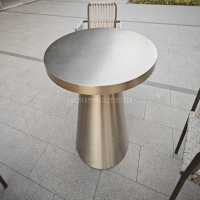Welcome to the website for landscape facilities products and knowledge.
How does the table’s shape influence the flow of conversation in collaborative settings?
The geometry of our meeting tables plays a surprisingly pivotal role in shaping how we communicate and collaborate. While often overlooked in workspace design, table forms create invisible boundaries and channels that either facilitate or hinder the natural flow of conversation among participants.
Round tables have long been celebrated for their democratic qualities, eliminating hierarchical seating arrangements and enabling eye contact among all participants. This circular configuration encourages equal participation, reduces dominance by any single individual, and fosters a sense of unity among team members. The continuous surface allows conversations to flow smoothly around the table, making it ideal for brainstorming sessions and collaborative decision-making processes.
Rectangular tables, by contrast, create a different conversational landscape. These tables naturally establish a power dynamic with clear "head" positions, often occupied by meeting leaders or senior members. Conversations tend to flow lengthwise along the table, potentially creating subgroups and limiting cross-table dialogue. While this configuration works well for structured meetings with clear agendas, it may inadvertently silence quieter participants seated at the far ends.
Square tables present an interesting middle ground, offering some of the equality found in round tables while maintaining defined positions. However, the equal distances between participants can sometimes create formal atmospheres that inhibit spontaneous conversation. The corners may create subtle barriers that segment conversations into diagonal pairs rather than engaging the entire group.
Innovative table designs are emerging to address these communication challenges. Organic-shaped tables with flowing curves, modular configurations that can be rearranged, and hybrid designs incorporating both straight and curved elements are gaining popularity in modern collaborative spaces. These designs aim to combine the equality of round tables with the functional advantages of linear surfaces.
The choice of table shape should align with the primary purpose of the space. For creative collaboration and team building, round or oval tables often yield better results. For decision-making meetings or presentations, rectangular tables might be more appropriate. The most forward-thinking organizations are now incorporating multiple table shapes within their collaborative spaces, allowing teams to select configurations that best suit their specific communication needs.
Ultimately, understanding how table geometry influences conversation flow empowers organizations to design workspaces that actively enhance collaboration rather than accidentally hindering it. By making intentional choices about this fundamental piece of furniture, we can create environments where ideas flow freely and every voice has the opportunity to be heard.
Related search:

Recommendation
Outdoor Metal Table - Classic Outdoor Furniture, Stainless Steel Table, Durable and Reliable